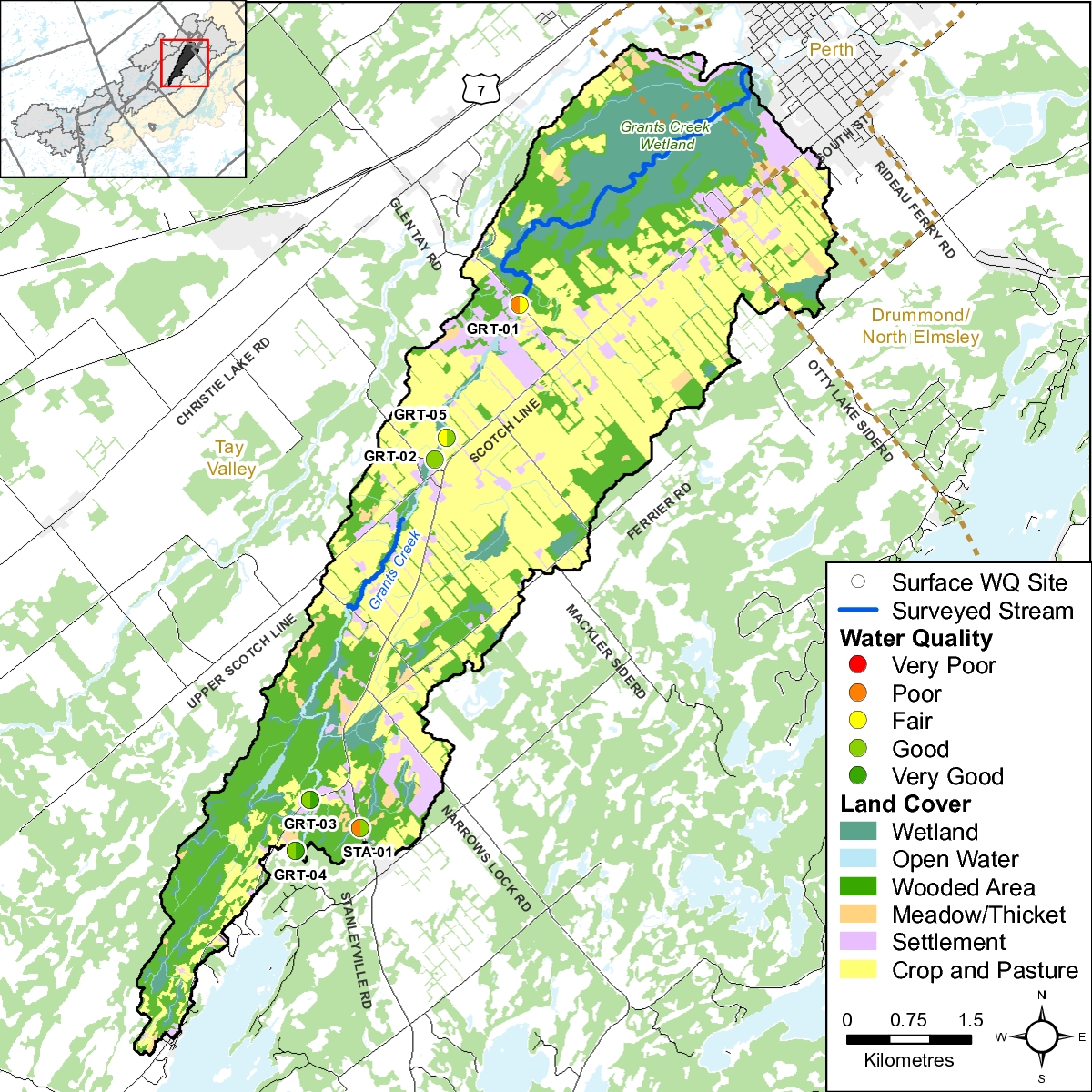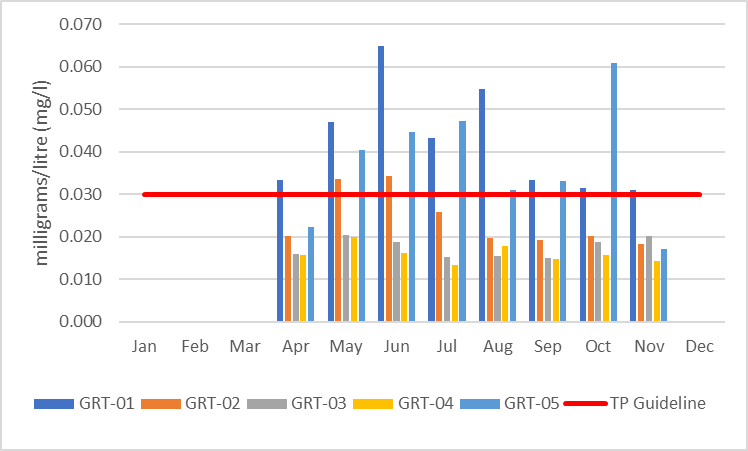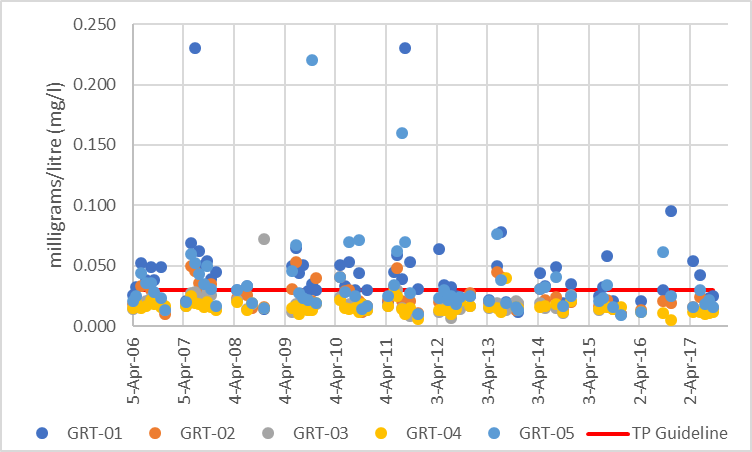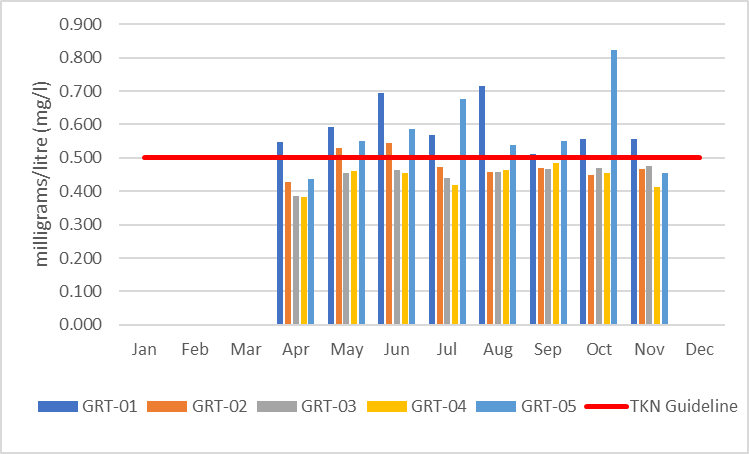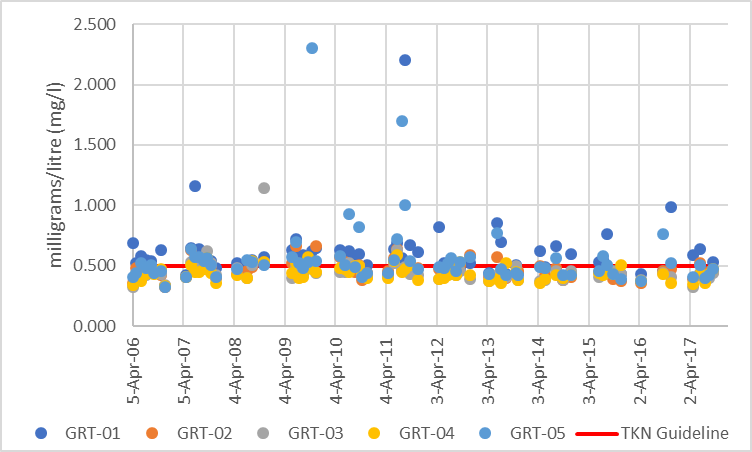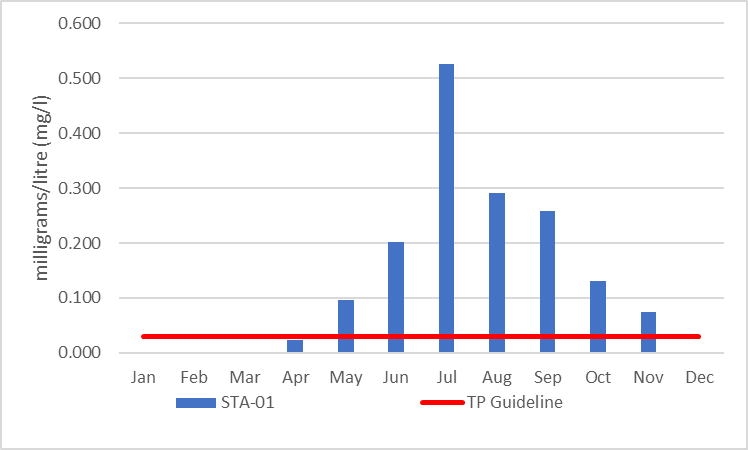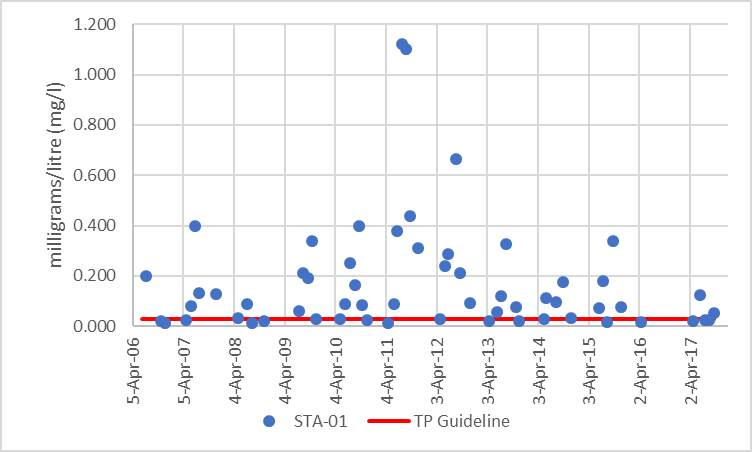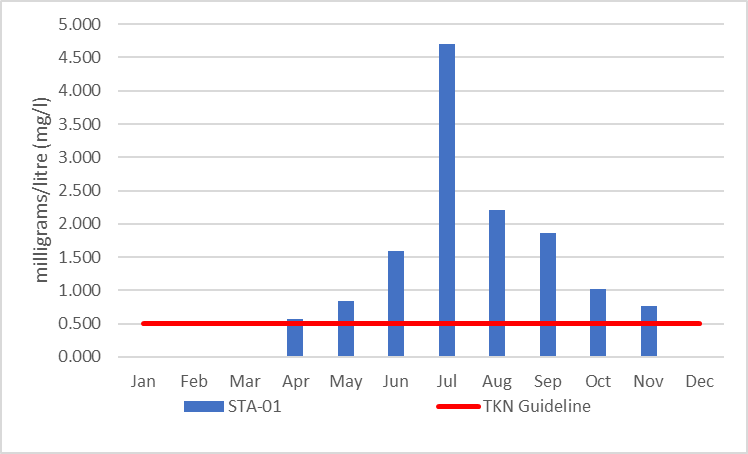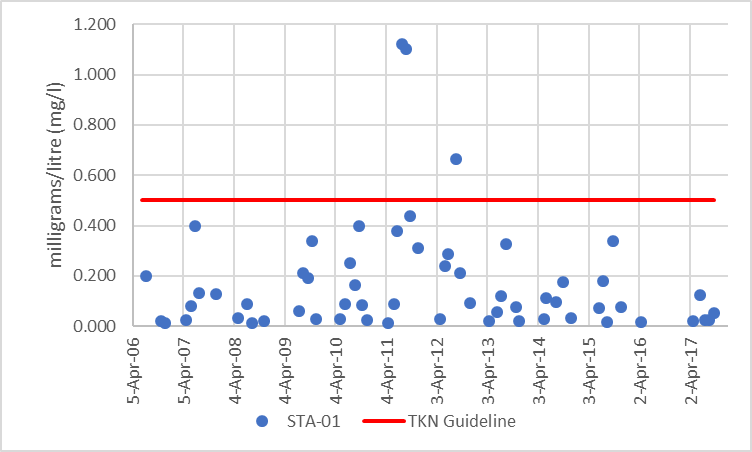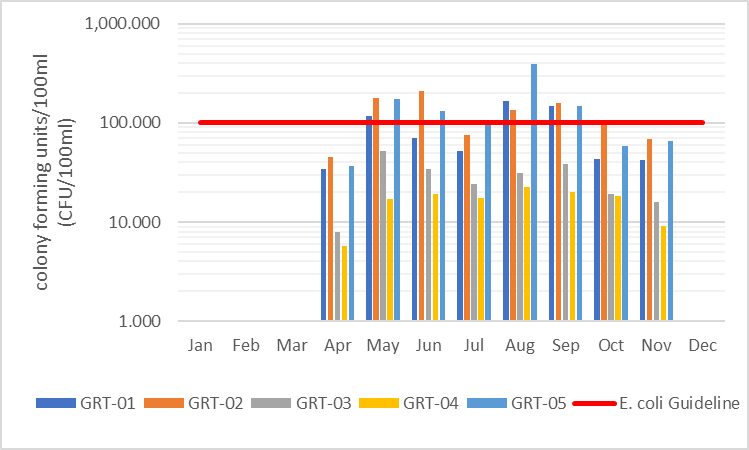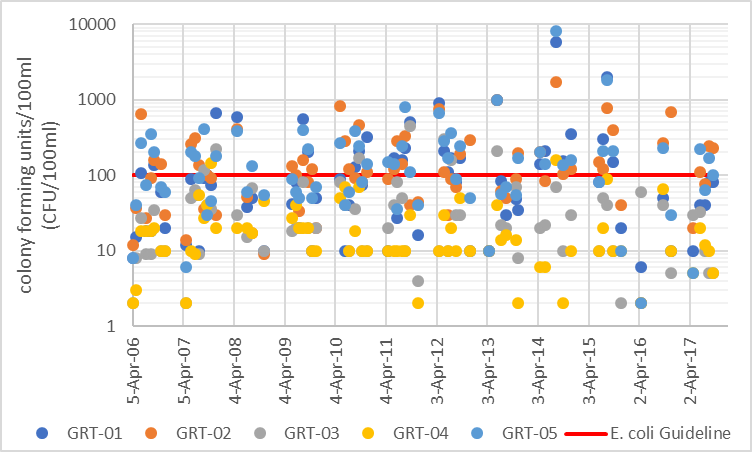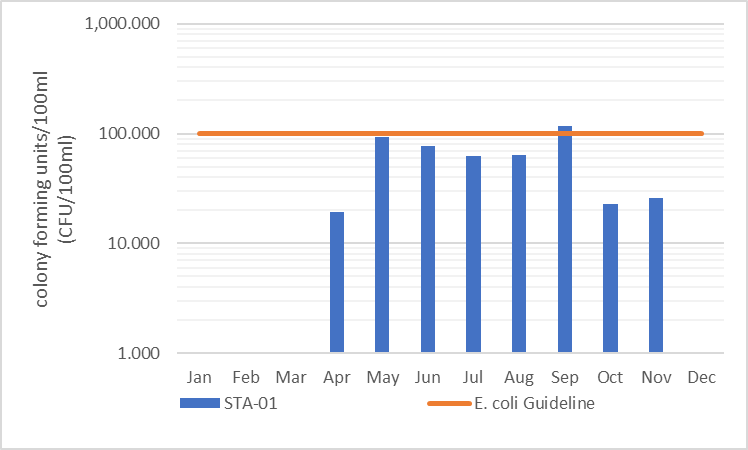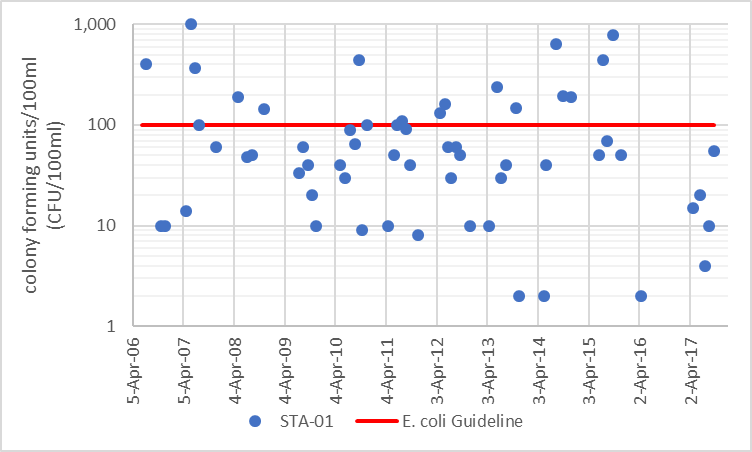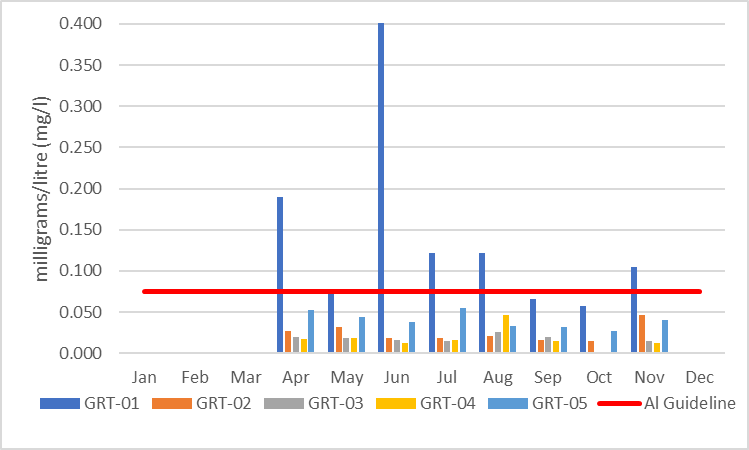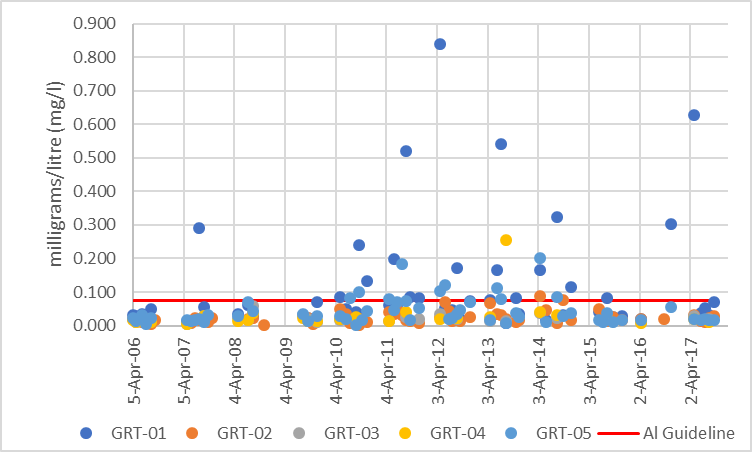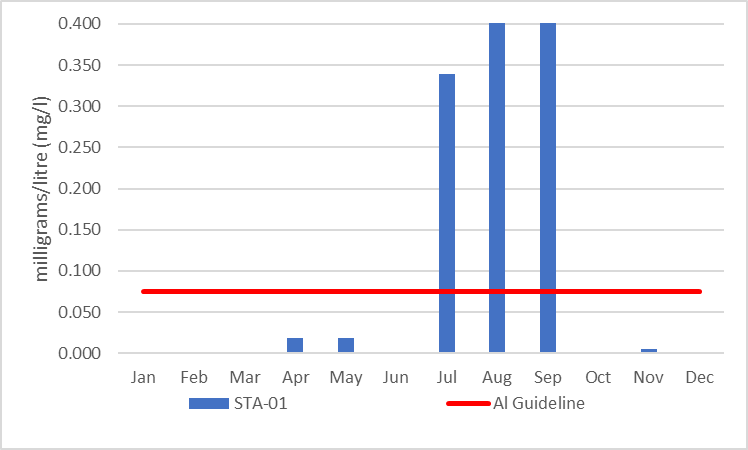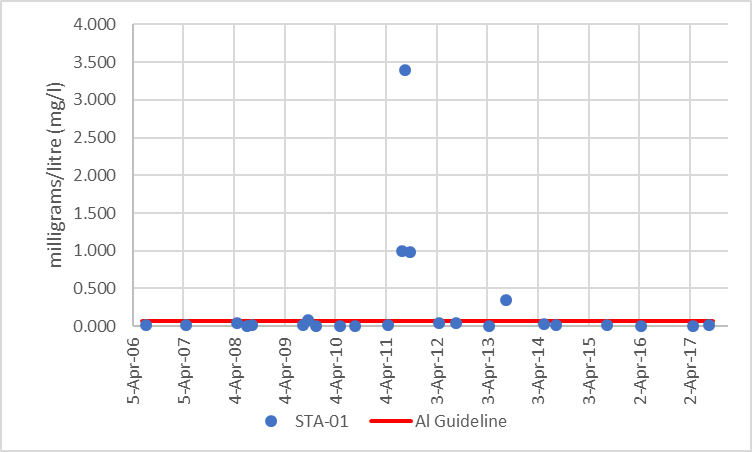2.0 Grants Creek Catchment: Water Quality Conditions
Surface water quality conditions in the Grants Creek catchment are monitored by the Rideau Valley Conservation Authority (RVCA) Baseline Water Quality Monitoring Program. The baseline water quality program focuses on streams; data is collected for 22 parameters including nutrients (total phosphorus and total Kjeldahl nitrogen), E. coli, metals (like aluminum and copper) and additional chemical/physical parameters (such as alkalinity, chlorides, pH and total suspended solids). Figure 2 shows the locations of monitoring sites in the catchment.
2.1 Grants Creek: Water Quality Rating
There are six monitored water quality sites in the Grants Creek Catchment, five of which are on Grants Creek (GRT-01 to GRT-05) and one site (STA-01) on an unnamed creek crossing Stanleyville Rd (Figure 2). The RVCA's water quality rating for these sites range from "Poor" to “Very Good” (Table 1) as determined by the Canadian Council of Ministers of the Environment (CCME) Water Quality Index.
A “Poor” rating indicates that water quality is frequently threatened or impaired; conditions often depart from natural or desirable levels. A rating of “Fair” indicates that water quality is usually protected but is occasionally threatened or impaired; conditions sometimes depart from natural or desirable levels. A rating of "Good" indicates that only a minor degree of threat or impairment is observed and conditions rarely depart from natural or desirable levels. “Very Good" indicates water quality is protected with a virtual absence of threat or impairment; conditions are very close to natural or pristine levels.
Each parameter is evaluated against established guidelines to determine water quality conditions. Those parameters that frequently exceed guidelines are presented below. Data has been analyzed over the 2006-2017 period for general trends and conditions. Table 1 shows the overall rating for the monitored surface water quality sites within the catchment and Table 2 outlines the Water Quality Index (WQI) scores and their corresponding ratings.
The scores at these sites are largely influenced by frequent high nutrient concentrations and occasional metal exceedances. For more information on the CCME WQI, please see the Tay River Subwatershed Report. For more information on the CCME WQI, please see the Tay River Subwatershed Report.
| Site | Location | 2006-2008 | 2009-2011 | 2012-2014 | 2015-2017 |
|---|---|---|---|---|---|
| GRT-04 | Grants Creek at Pike Lake Dam | Good (91) | Good (94) | Good (85) | Very Good (97) |
| GRT-03 | Grants Creek at County Rd 10. | Good (85) | Good (91) | Very Good (97) | Very Good (100) |
| GRT-02 | Grants Creek at Upper Scotch Line | Good (84) | Good (86) | Good (86) | Good (92) |
| GRT-05 | Grants Creek downstream of Upper Scotch Line | Good (80) | Fair (75) | Fair (76) | Good (86) |
| GRT-01 | Grants Creek at Glen Tay Rd. | Poor (59) | Good (82) | Fair (70) | Fair (70) |
| STA-01 | Unnamed creek crossing Stanleyville Rd upstream of Pike Lake | Poor (68) | Very Poor (44) | Poor (55) | Good (80) |
| Rating | Index Score |
|---|---|
| Very Good (Excellent) | 95-100 |
| Good | 80-94 |
| Fair | 65-79 |
| Poor (Marginal) | 45-64 |
| Very Poor (Poor) | 0-44 |
2.1.1 Grants Creek: Nutrients
Total phosphorus (TP) is used as a primary indicator of excessive nutrient loading and may contribute to abundant aquatic vegetation growth and depleted dissolved oxygen levels. The Provincial Water Quality Objective (PWQO) is used as the TP Guideline and states that in streams concentrations greater than 0.030 mg/l indicate an excessive amount of TP.
Total Kjeldahl nitrogen (TKN) is used as secondary indicators of nutrient loading. RVCA uses a guideline of 0.500 mg/l to assess TKN[1] .
Tables 3 and 4 summarize average nutrient concentrations at monitored sites within the Grants Creek catchment and show the proportion of results that meet the guidelines.
| Total Phosphorus 2006-2017 | |||
|---|---|---|---|
| Site | Average (mg/l) | Below Guideline | No. Samples |
| GRT-04 | 0.016 | 99% | 72 |
| GRT-03 | 0.017 | 97% | 72 |
| GRT-02 | 0.023 | 74% | 72 |
| GRT-05 | 0.035 | 58% | 72 |
| GRT-01 | 0.043 | 33% | 72 |
| STA-01 | 0.179 | 27% | 59 |
| Total Kjeldahl Nitrogen 2006-2017 | |||
|---|---|---|---|
| Site | Average (mg/l) | Below Guideline | No. Samples |
| GRT-04 | 0.439 | 81% | 72 |
| GRT-03 | 0.450 | 83% | 71 |
| GRT-02 | 0.475 | 65% | 72 |
| GRT-05 | 0.559 | 49% | 72 |
| GRT-01 | 0.595 | 26% | 72 |
| STA-01 | 1.865 | 13% | 60 |
Monitoring Site GRT-04
Site GRT-04 is the at the outflow of Pike Lake, the source of Grants Creek. Almost all (99 percent) samples at this site were below the TP guideline from 2006-2017 (Figures 3 and 4). The average TP concentration in the at this site was 0.016 mg/l (Table 3), the monthly average concentrations are fairly consistent with a slight increase observed in May samples (Figure 3). Overall a decrease was observed in TP concentrations over the 2006-2017 period[2].
TKN concentrations show that the bulk of results (81 percent) were also below the guideline (Figure 6, Table 4). The average concentration over the 2006-2017 period was 0.439 mg/l (Table 4); monthly averages are comparable across the sampling season with the lowest concentrations observed in April and November (Figure 5). There was no significant trend found in TKN results at this site.
Monitoring Site GRT-03
Similar nutrient conditions to site GRT-04 are observed at site GRT-03. TP results were low, the average concentrations was 0.017 and 97 percent of samples were below the guideline (Table 3, Figure 4). As with the upstream site the highest concentrations were observed in May, with another period of slightly elevated results (with respect to average concentrations) in November (Figure 3).
The majority of TKN results were below the guideline (Figure 5 and 6), 83 percent of samples were below 0.500 mg/l (TKN Guideline) with an average concentration of 0.450 mg/l (Table 4). Average monthly concentrations were comparable, with the exception of lower concentrations in April (Figure 5).
A decreasing trend was observed in both TP and TKN concentrations at this site.
Monitoring Site GRT-02
Site GRT-02 is further downstream from GRT-04 and GRT-03. While an increase in TP concentrations is observed relative to the two upstream sites (GRT-03 and GRT-04) TP concentrations may be considered low-moderate. Seventy-four percent of samples at this site were below the TP guideline from 2006-2017 (Figures 3 and 4), and the average TP concentration in the at this site was 0.023 mg/l (Table 3). The monthly average concentrations exceeded the guideline in May and June, but are below the guideline in other months (Figure 3). A decrease was observed in TP concentrations over the 2006-2017 period.
TKN concentrations show that the bulk of results (65 percent) were also below the guideline (Figure 6, Table 4). The average concentration over the 2006-2017 period was 0.475 mg/l (Table 4). A similar pattern to TP results is observed; monthly averages are comparable, elevated results were observed in May and June, and remaining monthly averages are below the guideline (Figure 5). A declining trend in TKN concentrations was also found at this site.
Monitoring Site GRT-05
Moving further downstream nutrient concentrations continue to increase. The majority of TP results (58%) are below the guideline, however, the average concentrations was elevated at 0.035 mg/l (Table 3, Figure 4). Concentrations appear to increase from Spring through early Summer, with a second increase observed in October (Figure 3). As with other upstream sites an overall declining trend was found in TP concentrations.
The majority (49%) of TKN results were also above the guideline (Figure 5 and 6), with an average concentration of 0.559 mg/l (Table 4). Average monthly concentrations patterns were comparable with TP results, increasing from April to July, with an elevated period observed in October (Figure 5). No trend was detected in TKN concentrations at this site.
Monitoring Site GRT-01
Site GRT-01 is the last monitored site before Grants Creek meets the Tay River further downstream; increased TP concentrations continued to be observed at this site. Only 33 percent of samples were below the TP guideline from 2006-2017 (Figures 3 and 4), and the average TP concentration at this site was 0.043 mg/l (Table 3). The monthly average concentrations exceeded the guideline from May to July, with lower average concentrations into the late summer and fall (Figure 3). A weak, significant decrease in TP concentrations was observed in the 2006-2017 data set.
TKN concentrations show that the bulk of results were also elevated (Figure 6, Table 4). Only 26 percent of samples were below the guideline, the average concentration over the 2006-2017 period was 0.595 mg/l (Table 4). As with TP data for this site, increasing monthly average concentrations were observed from April-July; concentrations in subsequent months are lower, although they still exceed the guideline (Table 3). No trend was observed in TKN concentrations over the 2006-2017 period.
Monitoring Site STA-01
This site does not drain into Grant's Creek though has been included as part of this catchment. STA-01 monitors water quality in a small creek that drains a former waste management site along Stanleyville Rd to Pike Lake. The majority of TP samples are elevated; only 27% of samples at this site were below the guideline from 2006-2017 (Figures 7 and 8) and the average TP concentration was 0.179 (Table 3). the monthly average concentrations are fairly consistent with a slight increase observed in May samples (Figure 7). From data calculated for the monthly averages, concentrations increase through the summer peaking in July, after which a decrease is observed.
TKN results also show elevated concentrations are a feature of this water body. Thirteen percent of samples were also below the guideline (Figure 10, Table 4). The average concentration over the 2006-2017 period was 1.865 mg/l (Table 4). Averaged monthly data also shows an increase from April to July in TKN concentrations followed by a decrease in the following months (Figure 9).
There was no significant trend detected in either TP or TKN results. It should be noticed that during the late summer this creek often has very low water levels which may have impacted sampling efforts.
Summary of Grants Creek Nutrients
The data collected in Grants Creek provides evidence of nutrient enrichment downstream along the creek. Overall, there is a declining trend in TP concentrations at all sites, with a decrease in TKN observed at sites GRT-03 and GRT-02. This provides support that cumulative changes throughout the catchment have reduced nutrient loadings to the creek. This should be taken as a positive sign as high nutrient concentrations can help stimulate the growth of algae blooms and other aquatic vegetation in a water body and deplete oxygen levels as the vegetation dies off. However, elevated concentrations are still a concern in the lower reaches. Therefore, it is important to continue best management practices such as minimizing storm water runoff, enhanced shoreline buffers, minimizing/discontinuing the use of fertilizers and restricting livestock access in upstream agricultural areas to help to further reduce nutrient pollution and to continue to protect and enhance water quality conditions within Grants Creek.
Conditions at STA-01 have remained unchanged. As this is a very small watercourse with limited flow it is unlikely that this is having a significant impact of downstream water bodies such as Pike Lake. It should be noted that in 2011 extra sampling was done at this site, as well as upstream and downstream locations to determine sources of high nutrients and downstream impacts. Overall results were found to be inconclusive and any elevated nutrients were attenuated by the large wetland complex downstream of this site. For more information, please contact the RVCA Surface Water Quality Coordinator.
2.1.2 Grants Creek: E. coli
Escherichia coli (E. coli) is used as an indicator of bacterial pollution from human or animal waste; in elevated concentrations it can pose a risk to human health. The PWQO of 100 colony forming units/100 millilitres (CFU/100 ml) is used. E. coli counts greater than this guideline indicate that bacterial contamination may be a problem within a water body.
Table 5 summarizes the geometric mean[3] for the monitored sites within the Grants Creek catchment and shows the proportion of samples that meet the E. coli guideline of 100 CFU/100 ml. The results of the geometric mean with respect to the guideline Figures 11-13 respectively.
| E. coli 2006-2017 | |||
|---|---|---|---|
| Site | Geometric Mean (CFU/100ml) | Below Guideline | No. Samples |
| GRT-04 | 14 | 97% | 72 |
| GRT-03 | 23 | 90% | 72 |
| GRT-02 | 103 | 44% | 72 |
| GRT-05 | 109 | 46% | 72 |
| GRT-01 | 71 | 61% | 72 |
| STA-01 | 48 | 68% | 60 |
Monitoring Site GRT-04
E. coli counts at site GRT-04 indicate little concern with regard to bacterial contamination. Ninety-seven percent of samples were below the guideline (Figures 11-12) and the count at the geometric mean was only 14 CFU/100ml (Table 5). Monthly E. coli counts were comparable, with lower numbers observed in April and November, likely due to cooler weather conditions which inhibits bacterial growth (Figure 12). No trend was noted in E. coli counts over the 2006-2017 period.
Monitoring Site GRT-03
Elevated E. coli counts at site GRT-03 were uncommon. Ninety percent of samples were below the guideline (Figure 12) from 2006-2017. The count at the geometric mean was 23 CFU/100ml (Table 5) and well below the guideline, the highest counts were recorded in May (Figure 11). As with site GRT-04 there was no significant trend in E. coli data over the 2006-2017 period.
Monitoring Site GRT-02
There is a noted increase in E. coli counts at site GRT-02 when compared to upstream sites (GRT-04 and GRT-03). Only 44% of samples were below the guideline, with a elevated count of 103 CFU/100ml at the geometric mean (Table 5, Figure 11). Monthly E. coli counts were variable across the sampling season, often exceeding the guideline (Figure 12). As with upstream sites no trend was noted in E. coli counts over the 2006-2017 period.
Monitoring Site GRT-05
The results for the GRT-05 are comparable to neighbouring site GRT-02. Forty-six percent of samples were below the guideline (Figure 12) from 2006-2017. The count at the geometric mean was above the guideline at 109 CFU/100ml (Table 5). As with site GRT-02 monthly counts were variable and often exceeded the guideline (Figure 12), no significant trend was noted at this site.
Monitoring Site GRT-01
The results for the GRT-01 show a reduction in downstream bacterial contamination from sites GRT-02 and GRT-05. The majority of samples (61%) were below the E. coli guideline as was the count of 71 CFU/100ml at the geometric mean (Table 5). A pattern of variable monthly counts continued to be observed (Figure 11), indicating that this data may not be strongly influenced by season. As with other sites on Grants Creek no significant trend was noted in E. coli counts.
Monitoring Site STA-01
The results for the STA-01 show that though periods of elevated concentrations occur bacterial contamination is not a concern at this site. The majority of samples (68%) were below the E. coli guideline as was the count of 48 CFU/100ml at the geometric mean (Figure 14, Table 5). Counts were lower in the spring and fall months likely due to cooler temperatures that inhibit bacterial growth (Figure 13).
Summary of Grants Creek Bacterial Contamination
Bacterial contamination does not appear to be a significant concern in most sections of Grants Creek. The data does suggest that upstream of site GRT-02 and GRT-05 (and likely directly downstream) bacterial pollution may be an issue given the high proportion of samples above the guideline and elevated counts at the geometric mean. Best management practices such as enhancing shoreline buffers, limiting livestock access and minimizing runoff in both developed and agricultural areas can help to protect water quality within Grants Creek.
2.1.3 Grants Creek: Metals
Of the metals routinely monitored in the Grants Creek Catchment, aluminum (Al) most commonly reported concentrations above its PWQO of 0.075 mg/l. In elevated concentrations, this metals can have toxic effects on sensitive aquatic species.
Table 6 summarize metal concentrations at sites and shows the proportion of samples that meet guidelines. Figures 15 and 16 show metal concentrations with respect to the guidelines for the two periods of interest, 2006-2017.
| Aluminum 2006-2017 | |||
|---|---|---|---|
| Site | Average (mg/l) | Below Guideline | No. Samples |
| GRT-04 | 0.029 | 96% | 27 |
| GRT-03 | 0.021 | 100% | 27 |
| GRT-02 | 0.025 | 97% | 60 |
| GRT-05 | 0.042 | 84% | 61 |
| GRT-01 | 0.110 | 67% | 60 |
| STA-01 | 0.255 | 79% | 24 |
Monitoring Site GRT-04
Aluminum concentrations at site GRT-04 show little evidence of this pollution in the upper reaches of the creek. Ninety-six percent of samples were below the guideline (Figures 15-16) with an average concentration of 0.029 mg/l (Table 6). At this site metals are only monitored in April and August to provide information on concentrations during high and low flow conditions. A few samples have been collected during other months but please note this is a limited number (Figure 16). No trend was noted in Al concentrations over the 2006-2017 period.
Monitoring Site GRT-03
As with the upstream site (GRT-04) elevated Al concentrations are not a feature of this site. All samples were below the guideline (Figure 16) from 2006-2017. The average concentration was 0.021 (Table 6) and well below the guideline. Metals concentrations are also only monitored in August and April (Figure 15) at this site. A few samples have been collected during other months but please note this is a limited number; no significant trend was noted in the available data.
Monitoring Site GRT-02
There is no noted increase Al concentrations at GRT-02 when compared to upstream sites (GRT-04 and GRT-03), as with upstream sites metal samples are primarily collected in April and August at GRT-02 (Figure 15). The majority of samples (97 percent) were below the guideline, an average concentration of 0.025 mg/l (Table 6, Figure 16). As with upstream sites no trend was observed in Al concentrations over the 2006-2017 period.
Monitoring Site GRT-05
The results at site GRT-05 show a slight increase in Al concentrations when compared to the previously discussed upstream sites. Eighty-four percent of samples were below the guideline (Figure 16) from 2006-2017 and the average concentration was 0.042 mg/l (Table 6). Metal concentrations are monitored monthly at this site due to the increase in commercial and agricultural activity in this reach of the the creek, all monthly average concentrations were below the guideline (Figure 15). No significant trend in Al concentration was noted at this site.
Monitoring Site GRT-01
The results for the GRT-01 show elevated Al concentration at this site (Figure 15). The majority of samples (67%) were below the Al guideline (Figure 16); however the average concentration was elevated at 0.110 mg/l (Table 6), indicating that periods of significantly elevated samples are contributing to a high overall concentration as shown in Figure 16. As with site GRT-05, samples are collected monthly at this site; elevated concentration are observed during the majority of sampled months (Figure 15). Overall, no significant trend was observed in Al concentrations at this site.
Monitoring Site STA-01
The results for the STA-01 show that few elevated samples have resulted in high average aluminum concentrations at this site. The majority of samples (79%) were below the Al guideline, however the average concentration exceeded it at 0.255 mg/l (Figure 17-18, Table 6). This site has typically only been monitored in April and August, though sampling may have occurred outside these months to capture other high or low flow events, concentrations have typically been higher during the summer months (Figure 17). There have been no significant trends in the data. Figure 18 shows that periods of very high aluminum concentrations have only been observed in 2011 and 2013; subsequent sampling has not found these high concentrations to persist at this site.
Summary of Grants Creek Metals
In the Grants Creek catchment aluminum concentrations have remained consistent through the monitoring period 2006-2017. The majority of elevated concentrations have been observed at the two most downstream sites in Grants Creek. This can likely be attributed of the cummulative impact of runoff within the catchment and the intensification of commercial, agricultural and developed land use upstream of these two sites (GRT-05 and GRT-01). Runoff due to meltwater and rainfall may pick up pollutants from farms, yards, roads and parking lots. Efforts should continue to be made to identify pollution sources and implement best management practices to reduce any inputs to improve overall stream health and lessen downstream impacts on the lower reach of Grants Creek and the Tay River.
1 No Ontario guideline for TKN is presently available; however, waters not influenced by excessive organic inputs typically range from 0.100 to 0.500 mg/l, Environment Canada (1979) Water Quality Sourcebook, A Guide to Water Quality Parameters, Inland Waters Directorate, Water Quality Branch, Ottawa, Canada.
2 Trends in the data were assessed using the Mann-Kendall trend test and Sens slope statistic.
3 A type of mean or average, which indicates the central tendency or typical value of a set of numbers by using the product of their values (as opposed to the arithmetic mean which uses their sum). It is often used to summarize a variable that varies over several orders of magnitude, such as E. coli counts.
